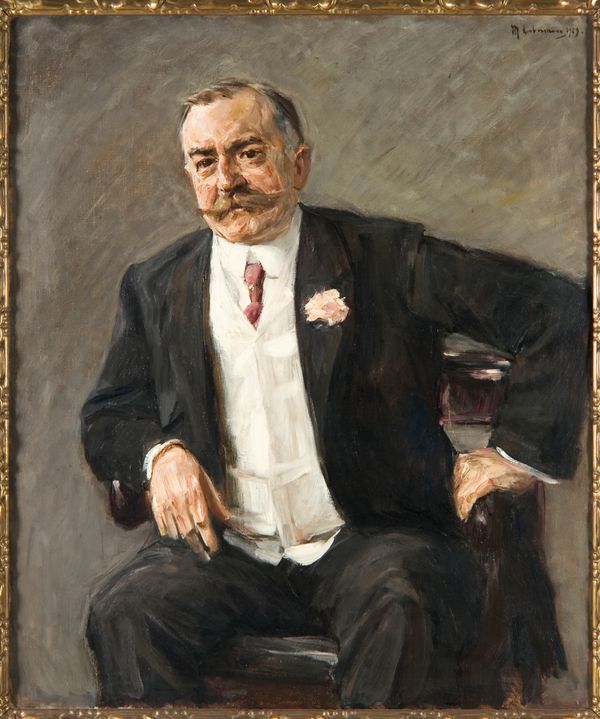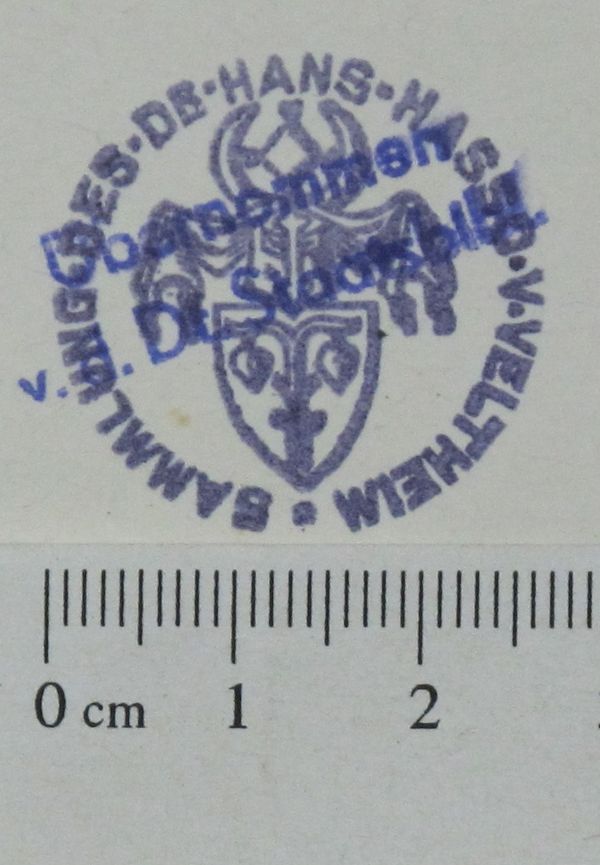| Genre | Painting |
| Materials | Oil on canvas |
| Size | 75 x 100 cm |
| Signature | bottom right: W. Leistikow |
Restored with the support of the Ernst von Siemens Kunststiftung
Research status
Provenance is unclear and research continues.
A simple search?
Very few of the works pre-dating 1945 acquired over time by the Berlinische Galerie came with provenance data. “Evening Light, Landscape with Two Oaks” was a rare exception. The art dealership who sold it to the museum in 1985, Asta von Bethmann-Hollweg Antiquitäten in Berlin, reported that it had come “from the collection of Rhenish industrialist Veltheim – Carl Duisberg”. It also stated that the painting was in its “original frame”.

The industrialist Carl Duisberg, 1909, portrait by Max Liebermann
Max Liebermann, Porträt Carl Duisberg (sitzend), 1909
© Photo: Sammlung Bayer AG, Leverkusen
The Bayer AG files record two works by Walter Leistikow; they include an index card for the painting
Index for the painting “Grunewald with a Red Evening Sky”
© Archiv Bayer AGThe provenance note refers to Carl Duisberg (1861–1935), general director and board chairman of the paint manufacturer formerly known as Friedr. Bayer & Co, a forerunner of the company now known as Bayer AG. Duisberg was an enthusiastic collector and encouraged the company to hang art in its offices.
The Bayer AG archives hold at least 30 files relating to Duisberg’s collection, including lists of purchases, registers of paintings and correspondence. Although the papers record two paintings by Walter Leistikow, they do not mention a work entitled “Evening Light, Landscape with Two Oaks”.
In 1910 Carl Duisberg bought one of two paintings by Leistikow entitled “Grunewald with a Red Evening Sky” from the Berlin gallery Haberstock. The dimensions 73 x 97 cm are similar to those of “Evening Light, Landscape with Two Oaks”. But is that Grunewald we can see in the painting?
Apart from Carl Duisberg, the provenance note mentions the Rhenish industrialist Veltheim. This probably means Hans-Hasso von Veltheim (1885–1956). In 1916 he married Hildegard Duisberg (1892–1964), Carl Duisberg’s daughter. In 1916 he married Hildegard Duisberg (1892–1964), Carl Duisberg’s daughter. They divorced in 1924. In the late 1920s Veltheim moved to the family estate in Ostrau near Halle (Saale). In 1945 the town was occupied by US troops. They offered to transport Veltheim’s belongings to the Western Zones, but the plan went wrong. In October 1945 Soviet troops took over Ostrau; Veltheim’s property was seized. He managed to escape to the West. His art collection, the library and the manor house furniture remained in Ostrau. We do not know if “Evening Light, Landscape with Two Oaks” was among the works left behind.

A mark of provenance: the books in Hans-Hasso von Veltheim’s library are stamped to identify their owner.
As we cannot be sure whether the painting was in either Duisberg’s collection or Hans-Hasso von Veltheim’s collection, we can conclude that this provenance is plausible, but we cannot confirm it. The work itself, which is probably no longer on its original stretcher frame, offers no clues to its history. It is unlikely that this decorative frame really is the “original frame”. There is no stamp on it like the one found in books owned by Hans-Hasso von Veltheim, nor any other form of identification.
